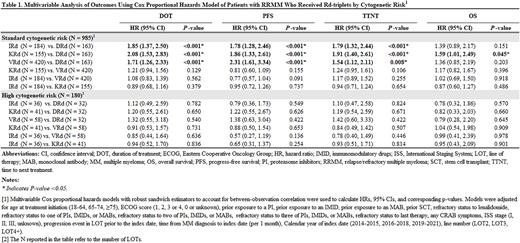Abstract
Introduction: Patients with relapsed/refractory multiple myeloma (RRMM) and high cytogenetic risk have poor prognosis. Despite the proven efficacy of lenalidomide and dexamethasone (Rd)-based triplet regimens in the RRMM population, further investigation of these triplet regimens in RRMM patients with standard and high cytogenetic risk is needed to inform the optimal treatment approach for such patients, especially given the lack of head-to-head clinical trials for these regimens. This real-world study compared the effectiveness of Rd in combination with proteasome inhibitors, ixazomib (I), carfilzomib (K), and bortezomib (V), or monoclonal antibodies, elotuzumab (E) and daratumumab (D) with respect to treatment outcomes among RRMM patients in the United States (US) within subgroups defined by cytogenetic risk.
Methods: The Flatiron Health Database (01/01/2014-09/30/2020) was used for this retrospective longitudinal study. Adult RRMM patients who initiated IRd, KRd, VRd, ERd, or DRd in line of therapy 2 or later (LOT2+) on or after 01/01/2014 were included. High cytogenetic risk was defined as the presence of del[17p], t[4;14], or t[14;16] by fluorescence in situ hybridization or karyotype tests. Patients with evidence of the tests but without the presence of these abnormalities were defined as standard risk. Index was the date of initiation for each LOT (multiple LOTs per patient were included); baseline was the 6-month period pre-index. Multivariable Cox proportional hazards models were used to compare duration of therapy (DOT), progression free survival (PFS), time to next therapy (TTNT), and overall survival (OS) between regimens. Patients who did not experience the event were censored at end of observation. Analyses were conducted separately in patients with high cytogenetic risk and in those with standard cytogenetic risk. Comparisons with ERd are not presented due to limited sample size.
Results: A total of 1,185 patients contributed to 1,332 LOTs, of which 180 (13.5%) had high cytogenetic risk (IRd: n=36; KRd: n=41; VRd: n=58; ERd: n=13; DRd: n=32), 985 (73.9%) had standard cytogenetic risk (IRd: n=184; KRd: n=155; VRd: n=420; ERd: n=63; DRd: n=163), and 167 (12.5%) had unknown risk.
In patients with standard cytogenetic risk, median age was 71 years and the majority (89.9%) of patients were treated in community settings; most regimens were in LOT2 (64.0%). Among these patients, DRd was associated with longer DOT compared to IRd (adjusted hazard ratio [95% confidence interval]: 1.85 [1.37, 2.50]), KRd (2.08 [1.53, 2.83]), and VRd (1.71 [1.26, 2.33]). Similarly, DRd was associated with prolonged PFS in comparison to all triplets (IRd: 1.78 [1.28, 2.46]; KRd: 1.86 [1.33, 2.61]; VRd: 2.31 [1.61, 3.34]), as well as longer TTNT (IRd: 1.79 [1.32, 2.44]; KRd: 1.91 [1.40, 2.61]; VRd: 1.54 [1.12, 2.11]). KRd was associated with shorter OS compared with DRd (1.59 [1.01, 2.49]). No other statistically significant differences were observed.
In patients with high cytogenetic risk, del[17p] (55.6%) and t[4;14] (38.9%) were the most frequent cytogenetic abnormalities, while a smaller proportion of patients had t[14;16] (14.4%). Median age was 69 years and almost all patients (90.0%) were treated in community settings; most (63.9%) regimens were in LOT2. High risk patients appeared to have comparable outcomes across triplet regimens as no statistical significance was detected in any pair-wise comparisons. Comparative results are shown in Table 1.Conclusions: This real-world study assessed RRMM patients treated primarily within US community settings. In patients with standard cytogenetic risk, DRd was associated with statistically significantly better PFS, DOT, and TTNT than PI-containing Rd-based triplets and better OS compared to KRd. In patients with high cytogenetic risk, results suggest comparable effectiveness of Rd-based triplet regimens, although the interpretation of these results is limited by the small sample size. These findings highlight the importance of cytogenetic risk when making treatment recommendations for RRMM patients, while further elucidating the effectiveness of triplet therapies in routine clinical care. Among high risk patients, larger studies are needed to clarify the effectiveness of various Rd-triplets currently FDA-approved for the broader RRMM population.
Disclosures
Cheng:Takeda: Other: I am an employee of Analysis Group, Inc, which received research funding from Takeda for this study.. Cherepanov:Takeda: Current Employment, Current equity holder in private company. DerSarkissian:Takeda: Other: I am an employee of Analysis Group, Inc, which received research funding from Takeda for this study.; AstraZeneca: Research Funding; Analysis Group: Current Employment. Stull:Takeda: Current Employment. Huang:Takeda: Current Employment, Current equity holder in publicly-traded company. Hilts:Takeda: Other: I am an employee of Analysis Group, Inc, which received research funding from Takeda for this study.. Chun:Takeda: Other: I am an employee of Analysis Group, Inc, which received research funding from Takeda for this study.. Duh:Takeda Oncology: Research Funding; Novartis: Research Funding; AstraZeneca: Research Funding; Shire: Research Funding; GSK: Research Funding; Blueprint Medicine: Research Funding; Merck: Research Funding; Apellis Pharmaceuticals: Research Funding; Pharmacyclics: Research Funding.
Author notes
Asterisk with author names denotes non-ASH members.


This feature is available to Subscribers Only
Sign In or Create an Account Close Modal